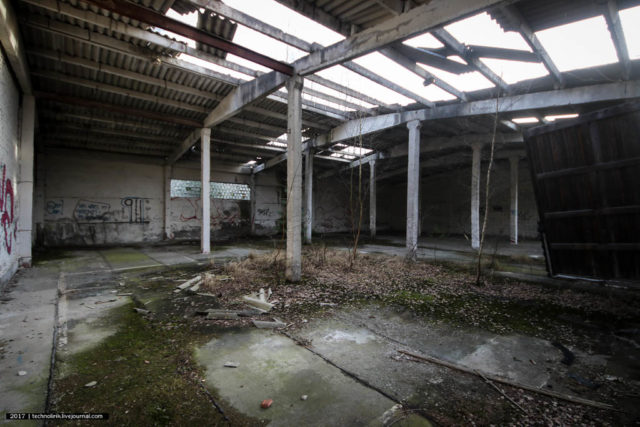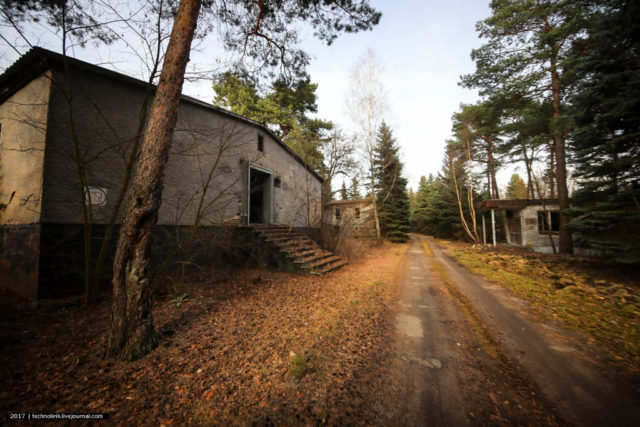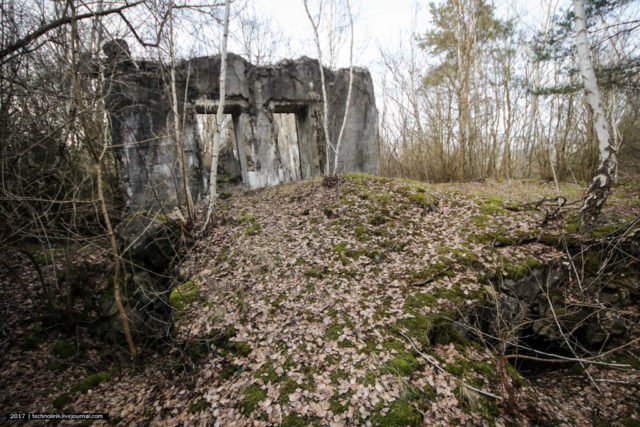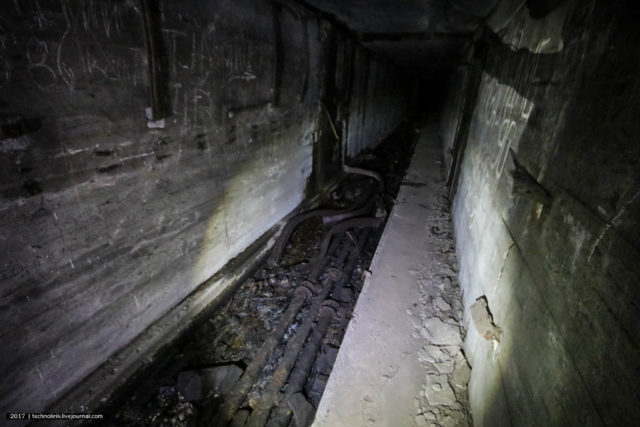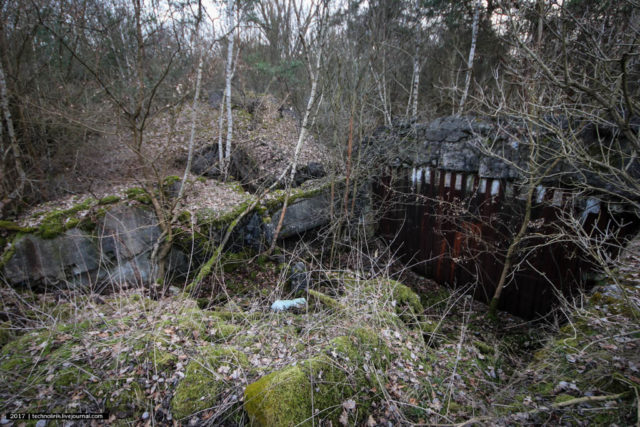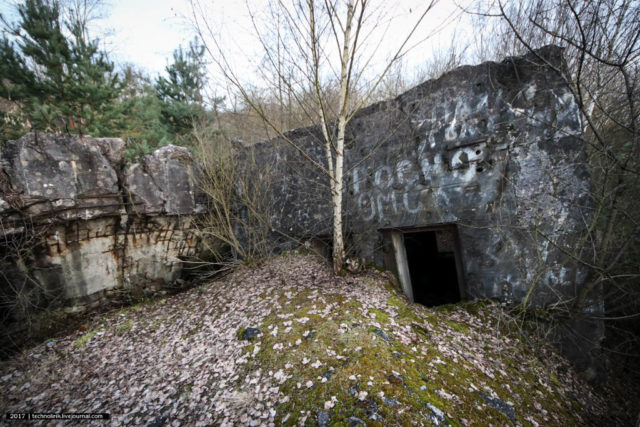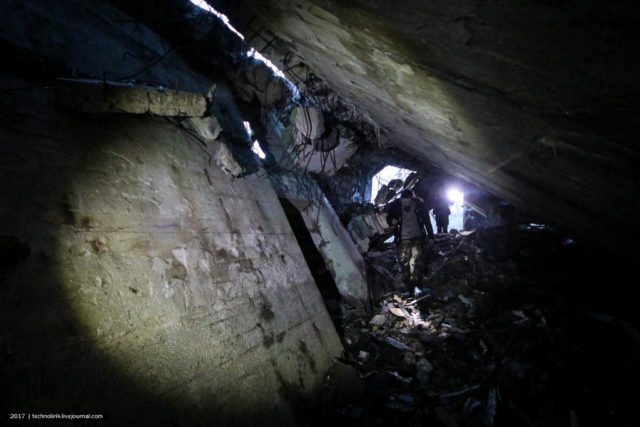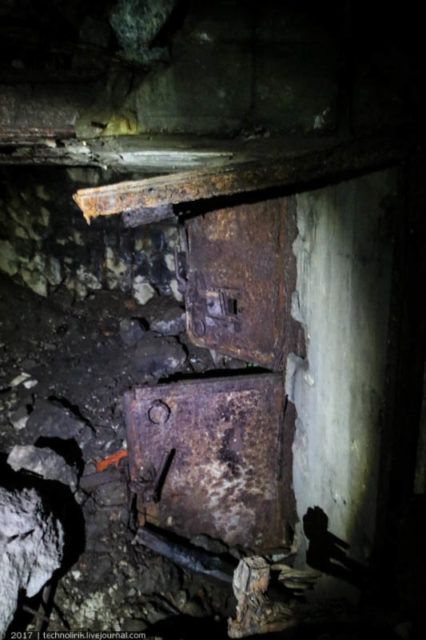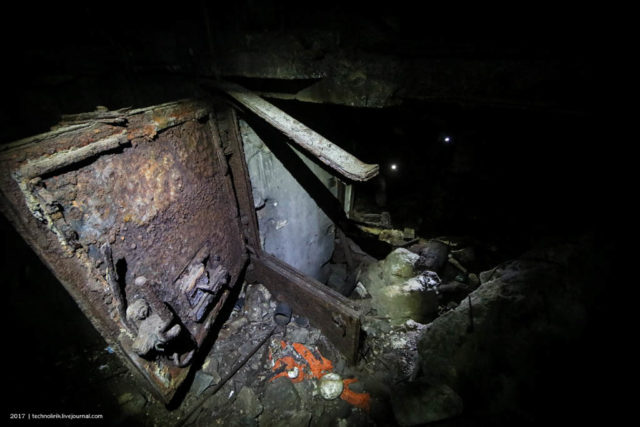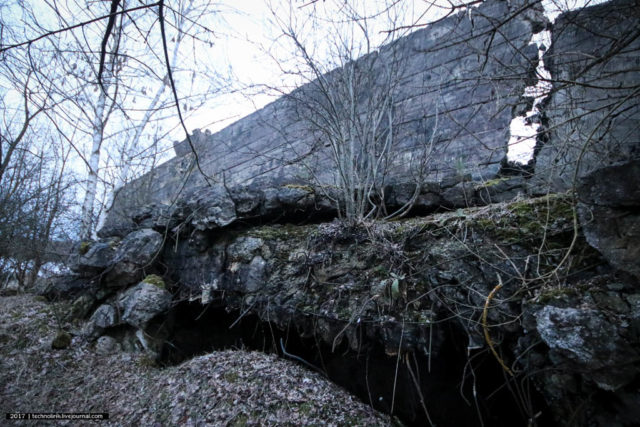The Bunker complex Maybach II is located on the outskirts of Wünsdorf, 35 miles south of Berlin. To this day, very little is known about it since it used to be a top-secret facility of the Third Reich. During the Second World War this bunker complex housed the headquarters of the Supreme High Command of the Wehrmacht, subordinated only to the Führer himself.
Construction of Maybach II began in 1939 and was completed in just one year. The facility occupied a large area. It was disguised as a village, so each bunker was built with a triangular roof to imitate the architecture of a village home.
The complex had five levels, two of which were underground. Initially, only 9 bunkers were supposed to be constructed, but at the end 11 were built. One of them was designated purely to technical purposes. The bunkers were connected with a network of underground corridors and one circular corridor connecting all of them.
Each bunker had a protected core inside. It was located on the ground and first floor and was surrounded by less secure rooms. The walls of the core were made out of reinforced concrete 1 meter thick. In the event of an air bombing, people inside the facility were to seek safety inside the protected core or on the two underground floors.
The Maybach II facility was connected by pneumatic mail to Zeppelin bunker located just a kilometer away. Zeppelin was where the largest and most important Nazi telecommunication system was based, so a fast and efficient link between it and Wehrmacht’s headquarters was essential.
Apart from bunkers, the complex also had two boiler houses and underground cisterns to store water and reserve fuel. The access to these was enabled by the system of underground corridors.
The Supreme High Command of the Wehrmacht was stationed here throughout the Second World War until April 20 1945, and the complex was taken by Red Army without much resistance. The bunker now ended up in Soviet occupied territory, which later became part of East Germany.
Following the Potsdam Agreement, the bunker was blown up in 1946 as part of a demilitarization programme. The once formidable complex became a site of wreckage with piles of massive chunks of concrete, although some structures managed to retain their original appearance comparatively well.
From 1950 to 1952, 8 of the 11 bunkers were blown up once more, this time in order to extract metal from the structure. This was done because the German Democratic Republic desperately needed raw materials. The explosions made it easier to extract steel elements but left the bunker complex in an even more desperate state.
In 1952 Soviets decided to station a military unit in the area, so the metal extraction process had to be stopped even though three bunkers still remained untouched. A military camp was established and remained there until 1994, when the unit was redeployed. While the camp was active, the ruins of Maybach II complex were used as a dumping ground and even now loads of Soviet-era military garbage can be seen around the complex.
Now the complex is derelict and deteriorating, but it still strikes with its size and monumentality. Almost all of the underground passageways are blocked off by debris, apart from a few which lead to underground passageways. Some underground corridors and bunkers are still preserved, which is incredible considering the amount of explosive power the complex was subjected to.
Photo and information source: technolirik
01. The Maybach bunker complex, like its twin brother, was located on the territory of the active Soviet unit on the outskirts of Wünsdorf, so until 1994, only the soldiers serving in this unit were available for investigation. At the entrance to the part we find an old kung and a row of boxes for equipment.
02. Inside the boxes there is emptiness and desolation.
03. Numerous buildings have been preserved on the territory of the part, and the territory itself is fenced with a fence, holes in which we did not find. I had to climb through the gate.
04. A cursory examination of barracks buildings showed that there is absolutely nothing to explore here. Everything is rendered clean.
05. On the way back, we will explore a few of the largest buildings in the area, but there will also be absolutely empty and not interesting.
06. Immediately after the barracks buildings, the area occupied by the ruins of the Maybach 2 bunker complex begins. The complex was similar to Maybach 1 and occupied a very large area.
07. At the present time, all this territory is abandoned and densely strewn with concrete ruins with numerous holes that go underground. True, all of them, with a single exception, are cut off by debris.
08. We were very lucky, because the only existing access to the ground we found on the first attempt. And this success inspired us to a more detailed study of the rest of the complex, which continued until the onset of deep darkness.
09. During the Soviet era, the ruins of the second Maybach were used as a dump – the concrete fragments of the complex are still lavishly littered with Soviet military garbage, among which even the skeletons of military trucks come across.
10. Judging by the abundance of ventilation vents in the first block examined by us, there was a technique requiring good cooling, possibly a diesel-geiger power station, or maybe a communication equipment. Now we do not know about it, since there was not any actual information about the top secret headquarters of the Wehrmacht. On the old pictures in the network on the site of the hole above the entrance there is still a grille, but, apparently, someone was picking it up for a souvenir.
1
1. We climb inside without knowing what a surprise is waiting for us there.
12. Nora on the lower level is very stiff and narrow
13. Zalaz wags zigzags and has several levels that need to be overcome in order to reach the basement level.
14. I climb after Stas after he says that inside there is room to move. I overcome the first level from which I took this picture.
15. It is actually a dangerous site
16. The bunker had five levels, three aboveground and two underground. It is possible to imagine the force of explosions that have been brought down on an object, if there is nothing left of the three above-ground levels, and two underground ones look like this. True, they also blasted it repeatedly, the first time in the Potsdam agreements, the second time – to extract the metal, which will be lower.
17. For all the years that I’m interested in underground research, I have not yet seen such a destroyed placet. Usually I estimate the degree of safety on a ten-point scale, perhaps this is the first object to which I will give the lowest ball-unit.
18. One of the rooms of the basement level. At the very bottom there was a diesel-generator power station or some other equipment, judging by the abundance of ventilation pipes. Before the explosion of the bunker complex, everything valuable was removed from it, and the German equipment left for the USSR. Perhaps, it is still used on some object.
19. The basement level
20. … what was our surprise when the underground passage led us into the ring tunnel that connected all 11 bunkers of the Maybach 2 facility underground.
21. What a surprise! There is practically no information on this site and there is no hint that there is access to the ground. But, it turned out that there still is. Just a few people know about it.
22. On the walls there are only Dembel inscriptions of Soviet servicemen
23. The only ones who mention having access to the underground system are the dudes from http://www.untergrund-brandenburg.de. I believe that out of a huge number of German diggers, they are almost the only ones who have been here.
24. The Maybach 2 facility was connected to an underground Zeppelin bunker, located one mile away, by pneumatic rail. Its pipes are still preserved inside the underground shabby.
25. Impressive! The first time I see pneumatic rail on an abandoned site and the second time in general in life (the first time I saw on a tour of the bunker Zeppelin which Ranet). It is noteworthy that I learned about the existence of such a method of communication from Orwell’s novel ”
On fresh impressions, I shot the video inside the shit.
26. This is how the exit looks to the surface. It is a vertical hole through a heap of debris – a real hell of claustrophobia.
27. Motivation after such a finding goes off scale and we continue to study the ruins of the bunker complex, looking into every hole.
28. A couple of words about the history and structure of the object. The construction of the Maybach 2 complex began immediately after the completion of the Maybach construction site 1 in the autumn of 1939 and went on at a rapid pace, so that the complex was completed in just one year and in October 1940 the object was transferred to the supreme high command of the Wehrmacht.
Maybach 2 was built on the same project as his brother and represented all the same type of bins disguised as a village village, only here they were 11 instead of 12 and circular pothers connecting them underground did not have a transverse connection like this was implemented in the Maybach 1 complex (in the diagram below).

On the scheme of the first mai-bah, you can see the patern, leaving to the south for 330 meters. It originally had to connect both bunker complexes by an underground passage, about a kilometer long, but then for some reason they refused to build it. So the objects were connected only by communication channels and pneumatic mail, but there was no underground communication between them.
This diagram shows the location of both Maybach complexes in the military town of Zossen (highlighted in red dotted lines). The
Photos of the second Maybach did not survive at all, but since both objects were built according to the same project, one can get an idea of the appearance of the complex from the Maybach photographs.
29. Initially, the construction of ten bunkers was planned, but in the end they built eleven, one of which was completely technical. The numbering of the bunkers continued the Maybach numbering 1 and began with the hopper A13, ending with the hopper A22. In addition to the bunkers themselves, two boiler houses and underground cisterns were built on the territory of the village to store water and fuel reserves, access to which was also possible by underground rubbish. In wartime, the supreme command of the Wehrmacht was stationed in the bunker complex, which used the facility until April 20, 1945, after which the bunker was hastily left when Soviet troops approached.
30. In 1946-1947, according to the directive No. 22 of the Allied Supervisory Board, the Maybach bunker complexes were blown up by Soviet sappers as part of the program to demilitarize Germany.
31. In 1950-1952 eight of the eleven bunkers in the complex were again blown up for the purpose of extracting a metal that the young socialist republic was sorely lacking. After undermining the objects, the steel bearing structures were dismantled, during which only the piles of concrete remained from the bunkers, which you can observe in these photographs. The work on cutting bunkers and extracting metal was carried out by the German national company VEB Bergungsbetrieb Berlin.
The memories of one of the workers of the enterprise that participated in the dismantling of the bunker complex in the early 1950s are preserved.
“From 1950 to July 1952 I worked for VEB Bergungsbetrieb Berlin, which was engaged in the dismantling of bunkers and other concrete structures to extract metal.We had facilities in Brandenburg, Ludwigsfelde and Zossen.The workers were usually recruited among the local population, so that many people came to the site on bicycles.The territory of Maybach 2 was not yet closed and there was no Soviet military unit.There were ten brigades working on the site, each of which was assigned a separate bunker.My brigade worked on extracting metal from the bun kers A20 and A21. In each brigade there were about ten men and five women. ”
“The working process consisted in the destruction of bunker ruins with the help of explosives and subsequent cleaning of steel structures from concrete by manual labor with the use of heavy hammers.” The mass of explosives per one blasting was normalized to 50 kilograms. “After cleaning the metal from concrete, it was transported to a warehouse located When the weather was bad, we worked in a circular gallery or in the spatial rooms of a bunker boiler room, where we were engaged in the dismantling of sewer and other pipes, including the pneumatic pipes I received about 300-400 marks a month, and in 1952 the work on the site was suddenly canceled. ”
34. Apparently, in 1952, the councils looked at this territory for the deployment of another military unit, and by that time only eight of the eleven bunkers had managed to be dismantled into metal, the other three at least in a state of eerie ruins, but survived until our time, we examined them last.
35. The pictures clearly show the thickness of the walls of the fortified part of the bunker, which was one meter.
36. Among the ruins, there are Soviet military artifacts, such as a dummy of an anti-tank mine.
37. Anti-tank mines were one of the most common toys in our yard, along with ampoules for chemical reconnaissance, machine-gun belts, cartridges and triplexes from tanks.
38. We go down to investigate the ruins of the next bunker.
39. Inside the wreckage of the bunker, generously mixed with Soviet military garbage.
40. We examined all the underground rooms.
41. That random finding of the entrance to the underground rubbish we had not bothered, so now we did not miss a single hole in the complex.
42. Stas is traditionally involved in exploration as the youngest and the most compact member of our group.
43. This hole does not lead anywhere, but inside there is the cadaverous smell of decaying animals.
44. Go ahead. Near the ruins of the bunkers were built economic buildings of the military unit, which in the intervening time have themselves become ruins.
45. Another mysterious portal, beckoning possible the presence of a hole under the ground.
46. The floor here is skewed, and entering the room there is an interesting deception of the senses.
47. To the left pulls not only gravity, but also a keen interest.
48. Pass the rusty armored door and enter the next room.
49. On the armored doors on the other side of the lock the original inscription has been preserved, urging to close doors urgently during an air alarm.
50. In addition to the original inscription, the door is also remarkable for the preserved islands of the original paint. Against the background of the scarcity of artifacts on the site, such a find is perceived as a real treasure.
51. Behind the door is a vast room with a destroyed ceiling and traditional pieces of concrete interspersed with reinforcement and Soviet rubbish.
52. We couldn’t go any further in this one.
53. Evaluate the slam!
54. Further our detour leads us to the last three bunkers to which the expropriators of the scrap metal of the young republic did not reach.
55. In the foreground there is a faded poster from the Soviet part, with the slogan that the soldier is painted with excellent service.
56. Here you can already see that the bunkers had the form of houses with sloping roofs.
57. Look inside. There are no surprises.
58. The area around is generally wild, during this walk we repeatedly met roe deer, and once twenty meters in front of me ran two huge black boar. Never before had I seen them so closely.
59. Impressive structure, even in its ruins there is power!
60. Next is a dump with the remnants of Soviet automotive equipment, there were even engines from cars and the front falshreshetka radiator from GAZ-21.
61. We go down to the floor below.
62. This is not an underground floor, but after the explosion of the bunker, it has shifted and is now, if not completely underground, then on a level with it.
63. Another armored door, pretty rusty.
64. We combed the entire floor, but we could not go down even lower. Everything is filled up.
65. This protected core is clearly visible in the center of the frame – it was inside it that led the entrance from the street. The thickness of the walls of the core was a meter of particularly strong fortification concrete. A careful glance will notice the remnants of the brickwork in the corner of the roof triangle – the gaps in the walls from both ends of the bunker were laid with ordinary brickwork, which, of course, did not represent any protection in case of bombardment.
66. But in case of an airborne alarm, all the workers of the facility were hiding inside the protected core and at two underground levels. So in terms of security here everything was thought out at the highest level. And the brickwork helped to mask the object for an ordinary apartment building.
67. The only graffiti on the site. I noticed it only when I took photos for the post.
68. The objects of the Third Reich impress with their gigantism. It is all the more strange that nobody knows about this bunker complex and no one visits it. But there is a lot to see here.
69. It’s only six o’clock in the evening and it’s already dusk.
70. It’s amazing how the roof leaned after the blast, but nevertheless the object did not collapse.
71. What exactly was there and what this bunker differed from others is unknown. 
72. On the roof of one of the concrete structures a rather large tree has grown.
73. We get inside the bunker from the previous picture. There is still a staircase leading to the upper floor.
74. The ceilings between the floors have been undermined, so in some places the doorways on the upper level break off over the void.
75. This is how the second and third floors of the bunker look.
76. On the first floor
77. Our indispensable scout dives into a hole …
78. … and soon emerges elsewhere, which is much more convenient for penetration
79. The minus first level was not anything remarkable, but on it we find the climb to the lowest level of the bunker, which was connected to the underground system of rooms
Unfortunately, I did not take my lanterns with me on this tour, because I did not think that they would be needed. It’s good that Stas took with him four lanterns, with which we also highlighted all that you saw in this post all this time.


